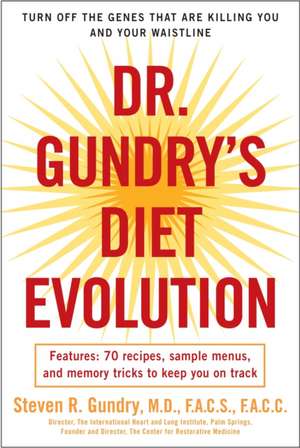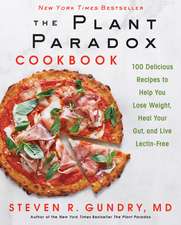Dr. Gundry's Diet Evolution: Turn Off the Genes That Are Killing You and Your Waistline
Autor Dr. Steven R Gundry, MDen Limba Engleză Paperback – 28 feb 2009
–Mehmet Oz, M.D., professor and vice chair of surgery, NY Presbyterian/Columbia Medical Center
Does losing weight and staying healthy feel like a battle? Well, it’s really a war. Your enemies are your own genes, backed by millions of years of evolution, and the only way to win is to outsmart them. Dr. Steven Gundry’s revolutionary book shares the health secrets other doctors won’t tell you:
• Why plants are “good” for you because they’re “bad” for you, and meat is “bad” because it’s “good” for you
• Why plateauing on this diet is actually a sign that you’re on the right track
• Why artificial sweeteners have the same effects as sugar on your health and your waistline
• Why taking antacids, statins, and drugs for high blood pressure and arthritis masks health issues instead of addressing them
Along with the meal planner, 70 delicious recipes, and inspirational stories, Dr. Gundry’s easy-to-memorize tips will keep you healthy and on course.
Preț: 94.87 lei
Puncte Express: 142
Preț estimativ în valută:
16.79€ • 19.59$ • 14.54£
16.79€ • 19.59$ • 14.54£
Carte tipărită la comandă
Livrare economică 26 februarie-12 martie
Livrare express 21-27 ianuarie pentru 30.88 lei
Preluare comenzi: 021 569.72.76
Specificații
ISBN-13: 9780307352125
ISBN-10: 0307352129
Pagini: 290
Dimensiuni: 155 x 231 x 15 mm
Greutate: 0.3 kg
Ediția:Reprint
Editura: Three Rivers Press (CA)
ISBN-10: 0307352129
Pagini: 290
Dimensiuni: 155 x 231 x 15 mm
Greutate: 0.3 kg
Ediția:Reprint
Editura: Three Rivers Press (CA)
Notă biografică
STEVEN R. GUNDRY, M.D., F.A.C.S., F.A.C.C., is the inventor of some of the most widely used heart-surgery devices and is renowned as an infant heart-transplant surgeon. Now, through his Center for Restorative Medicine, he helps patients avoid cardiac and other surgical procedures by using nutrition to reverse heart disease, diabetes, and arthritis. By bridging the gap between Dr. Atkins and Dr. Ornish and combining the best of the raw-foods and sugar-free plans, Dr. Gundry brings us to the next stage of diet evolution.
Extras
Chapter 1
YOUR GENES ARE
RUNNING THE SHOW
If you're anything like me, I know you're champing at the bit to get going on Diet Evolution, but hold your horses. I've found that most of us can stick to a program only if we understand how and why we got to our present state of affairs. The next four chapters will do just that.
You can thank Mom and Dad for your beautiful baby blues, as well as your hair color, height, and build. All these traits were encoded in copies of their genes--half of them her's, the other half his--that now reside in your body. Any children you have will in turn have copies of half of your genes and half of your partner's, and so on through generations to come. Determining our appearance and myriad other characteristics is just one way in which our genes rule our lives. As you'll soon learn, they also play a more clandestine role.
The answer to why almost all attempts to lose weight fail resides in your genes and the lies they've been feeding you. Once you understand how genes behave, and how their behavior controls your behavior, you'll be rewarded with an understanding of how you can lose those extra pounds, regain your health and vitality, and set the stage for a long, vigorous life. I'm sure you have heard that if you feed your genes right, all your health problems will disappear. But here you are stuck in the same old rut. I'm going to prove to you that you're in poor health and overweight because you're feeding your genes exactly what they want. Let me assure you, your genes are using you for their health and longevity, not yours. In fact, your longevity stands in their way. So sit back, open your mind, and be willing to suspend everything you've ever known about yourself. But first let's get down to basics.
GENES AS MICROCOMPUTERS
I've found that it helps to think of genes as tiny computer programs. On your computer, the letter A, for example, is "coded" as 1000001. Whenever I strike A on the keyboard, this code of 0's and 1's tells my computer to make an A appear on the screen. Think of your body as a computer and your genes as its operating system. Genes are pieces of information composed of hundreds or even thousands of sugars and proteins arranged in sequences that "spell out" the process the gene wants a cell to perform. They contain all the information needed to tell each cell what to do, but in this case, the keys that turn genes on or off are circulating hormones, neurotransmitters, and numerous other information carriers, particularly compounds in food. To continue the computer metaphor, these codes work much as typing an Internet address into your Web browser "tells" it what information you want.
Your genes are totally dependent on your body to protect them and house them until a new computer, in the form of your offspring, can take on these tasks. We need our genes as much as they need us: your body only works when its operating system--your genes--tells it what to do. Over millions of years, the communication between our genes and the human body has undergone continuous improvements and upgrades, all to ensure perpetuation of the genes. Despite myriad improvements--much like Vista replacing Windows, or Panther replacing Tiger--the basic operating system of your genetic program remains the same.
Okay, you head-shakers, if all this just seems too fantastic to believe, let me ask you why you have no trouble accepting the fact that you can watch Oprah on your cellphone, thanks to invisible electrical impulses from outer space that communicate with cell towers to activate tiny computer programs in your handheld appliance. An invisible but equally powerful, comparable process also happens in our bodies. Why do you think that after two months female dorm mates find their menstrual periods have synchronized? Their hormones sent messages through thin air--rather like text messaging--for them to ovulate at the same time. Hormones or plant chemicals stimulate genes to either switch on or off, determining what's going to happen in each cell, each part of the body, and each person.
YOUR GENETIC AUTOPILOT
Indeed, whether you realize it or not, your fate is being controlled by a hidden system that runs most of your cellular, hormonal, nervous system, and aging processes without your conscious input. It does this, so that the "thinking you" doesn't screw up the process of moving genetic material forward in time. If you've seen Stanley Kubrick's classic 2001: A Space Odyssey, in which intergalactic astronauts travel in a spaceship autopiloted by a computer they nickname "Hal," you can envision what's going on in your body. Hal takes care of running all the spacecraft's functions with minimal human input, but when the astronauts try to take over the vehicle, they realize that Hal is in total control and they're just along for the ride. When they attempt to thwart Hal, he tries to destroy them! Your autopilot is usually invisible, but I'm convinced that we constantly receive warning messages from it when processes head in the wrong direction.
For example, right now you're breathing without thinking about it, but the moment you do, you become conscious of your inhalations and exhalations. Now, let's do a quick test. Stop reading and time yourself as you hold your breath as long as you can. Were you able to go for two minutes? Up to three minutes? Or were you gasping for air at thirty seconds? You mean you were forced to take a breath? How can that be? Aren't you in charge of your body? I ask you to perform a simple task such as holding your breath, and now you're telling me that it was not under your control. Congratulations, you've just met your autopilot, your second self. This mechanism is there for a very important reason: to keep your genetic code from being wasted, in case you get the crazy notion to stop breathing when you're asleep or unconscious, among other things. That's just one of many examples of how Hal's mission is more important than yours!
We now realize that this operational program is far more than a second nervous system over which we have little or no control. Rather, it's a highly sophisticated system of specialized cells and the genes within them, including those that produce and sense hormones, govern your immune system, line your gut--all in constant communication with each other without your conscious input. If you're still having trouble with this concept, consider the autopilot program on an airplane. Once the human pilot inputs data about the destination into a computer, the autopilot controls direction, speed, thrust, flaps, pitch, and yaw. The autopilot doesn't "see" where the plane is going, doesn't "feel" how fast it is flying, but based on information sent from sensors in the plane or bouncing off satellites, it pretty much "knows" where it is in space and time, allowing it to "fly" the plane and land safely. But input the wrong information and the autopilot will dutifully fly you directly into a mountain, because that's where you told it to go. You'll understand more what I mean by this in the next chapter, when I'll explain how your current way of eating is giving your autopilot the wrong information, programming you for disaster.
PROGRAMMED FOR SURVIVAL
At the most basic level, our genes program us to do three things, all with the same purpose: to reproduce. That's right, your genetic code wants nothing more than to keep living. Notice that I didn't say it wants to keep you alive. Your genes are only using you as a host. When they're done with you, they throw the switch, activating the self-destruct "killer genes," and your days are numbered. Bummer! Now let's look at the three directives for which we are genetically hardwired.
Find and Conserve Energy This one sounds like a no-brainer, but for almost all animals (and plants, too), obtaining adequate nutrition has traditionally been an iffy proposition. Starvation not only kills directly, but also weakens an animal, leaving it more vulnerable to a predator. If you're dead, you can't pass on your genes to the next generation. So obtaining adequate calories with the least expenditure of effort is a primary driving force for all living things. If an animal is consistently in overdrive, burning up mucho calories in pursuit of food, its genes get the message that this combination of genetic material isn't a very good design and therefore should be weeded out. What this means for you is that your genes are programmed to send messages to your body to keep your metabolism low and to eat high-calorie foods.
Our genes are not only willing participants in this almost irresistible force to eat high-calorie foods, they also drive you to this behavior. Just as you can't suppress the eventual need to take a breath, the drive to conserve energy and obtain the most energy in the form of calories for the least effort is overpowering. Just think about that next time you get in the drive-through line at a fast-food joint. Then consider this: studies of overweight people show that if hunger strikes when there is no food in the house, they often won't make the effort to go out and get it.
Your computer program also initiates a self-destruct process when it senses that you're overconsuming fuel that will be needed by the next generation to continue the genetic mission. Remember, in any ecosystem, there is only so much food; if you appear to be taking more than your fair share, you're weeded out as a threat!
Avoid Injury and Pain With the possible exception of teenagers wanting to get their bodies pierced in places you didn't know could be pierced, animals have an innate desire to avoid pain; that's because in most circumstances, pain equates with the potential for injury. If an animal is wounded, it becomes predator bait and its genes die with it. Our hard-wired impulse to avoid pain helps protect us from injury, without the conscious brain having to waste valuable split seconds "thinking" about a response. So associated is pain with injury, and so severe the consequences of injury on the chances of survival, that we avoid pain at almost all costs.
Find Pleasure All animals are programmed to seek out pleasurable experiences, but copulation itself is not the only source of pleasure. The entire mating ritual stimulates feel-good receptors in the brain, which give rise to feelings of pleasure. Nor is it a coincidence that these receptors live right next door to those for sex hormones. Behaviors or compounds that stimulate these pleasure centers always override the other directives. Stimulate an electrode placed in any animal's brain pleasure center and it won't eat, sleep, or even avoid pain. Remarkably, the animal will even continue to press a button for this stimulus, avoiding food or water, until it blissfully starves to death. Likewise, given a choice between a pellet of food and a pellet of cocaine, a rat opts for cocaine until it dies. Now that's hardwiring!
Another more commonly used--and abused--pleasure-stimulating plant compound is found in fruit: sugar. It's in the plant's survival interest to have animals eat its fruit, including the seeds. But how does a plant make an animal eat the fruit instead of its leaves? Easy; just stimulate the animal's pleasure center. Rats don't overeat rat chow, yet give them sugar or milk chocolate and wham, they can't stop gobbling. Most of us are no different: we keep eating sugar-laden food until we're dead. And here's the worst part--sugar is exactly what your genes want you to eat.
And here's why. You have a certain type of shoulder joint, shared only with great apes, that enables apes to hang from and move under branches, including the flimsy ends of branches where most fruit hangs out of reach to other primates. Every study comparing apes to other primates confirms that we are designed to fatten up on fruit others can't reach--on a seasonal basis. This genetic and anatomic design foreshadows everything that has recently gone wrong with our current lifestyle, so stay with me to learn about its import in the coming chapters.
YOUR GENES VS. THE REST OF YOU
As you're coming to understand, like it or not, your genes have constructed you to achieve three main goals:
1. Deliver genes into the future by reproducing.
2. Ensure the survival of your genetic copies or other similar copies.
3. After accomplishing #1 and #2, get out of the way so you don't compete for limited resources with your offspring.
Now here is the clincher. The faster you accomplish these goals, the better things are from your genes' point of view.
To accomplish #1 and #2, you're programmed to find the most food using the least expenditure of energy by seeking out three pleasurable tastes: sugar, fat, and salt. From your genes' viewpoint, if food is nutritious (by this I mean high-calorie, not necessarily good for you) and enjoyable, you'll eat more of it, enhancing their chances for survival. As an example of how intricate this energy-conserving design is, as you get older, your adrenal glands produce progressively less and less DHEA, a hormone responsible for stimulating muscle-mass production. Under orders from your genes, your DHEA level drops as you age, causing you to lose about one-third of your muscle mass between the ages of 30 and 60. While distressing to us, the result is that you don't have to eat as much--muscles require calories--and violate rule #3: Don't compete for resources with your offspring.
WHEN PICKINGS ARE SLIM
Whenever conditions are unfavorable for the survival of offspring, a form of genetic override kicks in. During periods of food scarcity, pregnant women miscarry male fetuses in much higher numbers than female ones. This occurs in part because you need only one man to fertilize lots of females' eggs, but many females to populate the society. Also, because men generally are bigger and eat more, smaller, less muscular females put less strain on the food supply in difficult times. Scary to imagine that your genetic computer knows the sex of your unborn child and can instruct your body to jettison your precious cargo if it doesn't fit "the plan."
Not convinced yet? Women who don't have enough fat stores to successfully carry a pregnancy to term without eating don't ovulate. Why waste an egg if those genes won't be delivered into the future? That's why very thin female athletes and many anorexic women can't get pregnant. What happens when a mother is undernourished during her pregnancy? Her infant will have hunger genes that are permanently upregulated, meaning they are turned on. And here's the amazing thing: the hunger genes of those children's children and grandchildren are similarly activated for life. Often called "thrifty genes," these genes anticipate another period of scarcity and want to ensure that when it comes, the hungriest offspring with the largest fat stores will survive.
From the Hardcover edition.
YOUR GENES ARE
RUNNING THE SHOW
If you're anything like me, I know you're champing at the bit to get going on Diet Evolution, but hold your horses. I've found that most of us can stick to a program only if we understand how and why we got to our present state of affairs. The next four chapters will do just that.
You can thank Mom and Dad for your beautiful baby blues, as well as your hair color, height, and build. All these traits were encoded in copies of their genes--half of them her's, the other half his--that now reside in your body. Any children you have will in turn have copies of half of your genes and half of your partner's, and so on through generations to come. Determining our appearance and myriad other characteristics is just one way in which our genes rule our lives. As you'll soon learn, they also play a more clandestine role.
The answer to why almost all attempts to lose weight fail resides in your genes and the lies they've been feeding you. Once you understand how genes behave, and how their behavior controls your behavior, you'll be rewarded with an understanding of how you can lose those extra pounds, regain your health and vitality, and set the stage for a long, vigorous life. I'm sure you have heard that if you feed your genes right, all your health problems will disappear. But here you are stuck in the same old rut. I'm going to prove to you that you're in poor health and overweight because you're feeding your genes exactly what they want. Let me assure you, your genes are using you for their health and longevity, not yours. In fact, your longevity stands in their way. So sit back, open your mind, and be willing to suspend everything you've ever known about yourself. But first let's get down to basics.
GENES AS MICROCOMPUTERS
I've found that it helps to think of genes as tiny computer programs. On your computer, the letter A, for example, is "coded" as 1000001. Whenever I strike A on the keyboard, this code of 0's and 1's tells my computer to make an A appear on the screen. Think of your body as a computer and your genes as its operating system. Genes are pieces of information composed of hundreds or even thousands of sugars and proteins arranged in sequences that "spell out" the process the gene wants a cell to perform. They contain all the information needed to tell each cell what to do, but in this case, the keys that turn genes on or off are circulating hormones, neurotransmitters, and numerous other information carriers, particularly compounds in food. To continue the computer metaphor, these codes work much as typing an Internet address into your Web browser "tells" it what information you want.
Your genes are totally dependent on your body to protect them and house them until a new computer, in the form of your offspring, can take on these tasks. We need our genes as much as they need us: your body only works when its operating system--your genes--tells it what to do. Over millions of years, the communication between our genes and the human body has undergone continuous improvements and upgrades, all to ensure perpetuation of the genes. Despite myriad improvements--much like Vista replacing Windows, or Panther replacing Tiger--the basic operating system of your genetic program remains the same.
Okay, you head-shakers, if all this just seems too fantastic to believe, let me ask you why you have no trouble accepting the fact that you can watch Oprah on your cellphone, thanks to invisible electrical impulses from outer space that communicate with cell towers to activate tiny computer programs in your handheld appliance. An invisible but equally powerful, comparable process also happens in our bodies. Why do you think that after two months female dorm mates find their menstrual periods have synchronized? Their hormones sent messages through thin air--rather like text messaging--for them to ovulate at the same time. Hormones or plant chemicals stimulate genes to either switch on or off, determining what's going to happen in each cell, each part of the body, and each person.
YOUR GENETIC AUTOPILOT
Indeed, whether you realize it or not, your fate is being controlled by a hidden system that runs most of your cellular, hormonal, nervous system, and aging processes without your conscious input. It does this, so that the "thinking you" doesn't screw up the process of moving genetic material forward in time. If you've seen Stanley Kubrick's classic 2001: A Space Odyssey, in which intergalactic astronauts travel in a spaceship autopiloted by a computer they nickname "Hal," you can envision what's going on in your body. Hal takes care of running all the spacecraft's functions with minimal human input, but when the astronauts try to take over the vehicle, they realize that Hal is in total control and they're just along for the ride. When they attempt to thwart Hal, he tries to destroy them! Your autopilot is usually invisible, but I'm convinced that we constantly receive warning messages from it when processes head in the wrong direction.
For example, right now you're breathing without thinking about it, but the moment you do, you become conscious of your inhalations and exhalations. Now, let's do a quick test. Stop reading and time yourself as you hold your breath as long as you can. Were you able to go for two minutes? Up to three minutes? Or were you gasping for air at thirty seconds? You mean you were forced to take a breath? How can that be? Aren't you in charge of your body? I ask you to perform a simple task such as holding your breath, and now you're telling me that it was not under your control. Congratulations, you've just met your autopilot, your second self. This mechanism is there for a very important reason: to keep your genetic code from being wasted, in case you get the crazy notion to stop breathing when you're asleep or unconscious, among other things. That's just one of many examples of how Hal's mission is more important than yours!
We now realize that this operational program is far more than a second nervous system over which we have little or no control. Rather, it's a highly sophisticated system of specialized cells and the genes within them, including those that produce and sense hormones, govern your immune system, line your gut--all in constant communication with each other without your conscious input. If you're still having trouble with this concept, consider the autopilot program on an airplane. Once the human pilot inputs data about the destination into a computer, the autopilot controls direction, speed, thrust, flaps, pitch, and yaw. The autopilot doesn't "see" where the plane is going, doesn't "feel" how fast it is flying, but based on information sent from sensors in the plane or bouncing off satellites, it pretty much "knows" where it is in space and time, allowing it to "fly" the plane and land safely. But input the wrong information and the autopilot will dutifully fly you directly into a mountain, because that's where you told it to go. You'll understand more what I mean by this in the next chapter, when I'll explain how your current way of eating is giving your autopilot the wrong information, programming you for disaster.
PROGRAMMED FOR SURVIVAL
At the most basic level, our genes program us to do three things, all with the same purpose: to reproduce. That's right, your genetic code wants nothing more than to keep living. Notice that I didn't say it wants to keep you alive. Your genes are only using you as a host. When they're done with you, they throw the switch, activating the self-destruct "killer genes," and your days are numbered. Bummer! Now let's look at the three directives for which we are genetically hardwired.
Find and Conserve Energy This one sounds like a no-brainer, but for almost all animals (and plants, too), obtaining adequate nutrition has traditionally been an iffy proposition. Starvation not only kills directly, but also weakens an animal, leaving it more vulnerable to a predator. If you're dead, you can't pass on your genes to the next generation. So obtaining adequate calories with the least expenditure of effort is a primary driving force for all living things. If an animal is consistently in overdrive, burning up mucho calories in pursuit of food, its genes get the message that this combination of genetic material isn't a very good design and therefore should be weeded out. What this means for you is that your genes are programmed to send messages to your body to keep your metabolism low and to eat high-calorie foods.
Our genes are not only willing participants in this almost irresistible force to eat high-calorie foods, they also drive you to this behavior. Just as you can't suppress the eventual need to take a breath, the drive to conserve energy and obtain the most energy in the form of calories for the least effort is overpowering. Just think about that next time you get in the drive-through line at a fast-food joint. Then consider this: studies of overweight people show that if hunger strikes when there is no food in the house, they often won't make the effort to go out and get it.
Your computer program also initiates a self-destruct process when it senses that you're overconsuming fuel that will be needed by the next generation to continue the genetic mission. Remember, in any ecosystem, there is only so much food; if you appear to be taking more than your fair share, you're weeded out as a threat!
Avoid Injury and Pain With the possible exception of teenagers wanting to get their bodies pierced in places you didn't know could be pierced, animals have an innate desire to avoid pain; that's because in most circumstances, pain equates with the potential for injury. If an animal is wounded, it becomes predator bait and its genes die with it. Our hard-wired impulse to avoid pain helps protect us from injury, without the conscious brain having to waste valuable split seconds "thinking" about a response. So associated is pain with injury, and so severe the consequences of injury on the chances of survival, that we avoid pain at almost all costs.
Find Pleasure All animals are programmed to seek out pleasurable experiences, but copulation itself is not the only source of pleasure. The entire mating ritual stimulates feel-good receptors in the brain, which give rise to feelings of pleasure. Nor is it a coincidence that these receptors live right next door to those for sex hormones. Behaviors or compounds that stimulate these pleasure centers always override the other directives. Stimulate an electrode placed in any animal's brain pleasure center and it won't eat, sleep, or even avoid pain. Remarkably, the animal will even continue to press a button for this stimulus, avoiding food or water, until it blissfully starves to death. Likewise, given a choice between a pellet of food and a pellet of cocaine, a rat opts for cocaine until it dies. Now that's hardwiring!
Another more commonly used--and abused--pleasure-stimulating plant compound is found in fruit: sugar. It's in the plant's survival interest to have animals eat its fruit, including the seeds. But how does a plant make an animal eat the fruit instead of its leaves? Easy; just stimulate the animal's pleasure center. Rats don't overeat rat chow, yet give them sugar or milk chocolate and wham, they can't stop gobbling. Most of us are no different: we keep eating sugar-laden food until we're dead. And here's the worst part--sugar is exactly what your genes want you to eat.
And here's why. You have a certain type of shoulder joint, shared only with great apes, that enables apes to hang from and move under branches, including the flimsy ends of branches where most fruit hangs out of reach to other primates. Every study comparing apes to other primates confirms that we are designed to fatten up on fruit others can't reach--on a seasonal basis. This genetic and anatomic design foreshadows everything that has recently gone wrong with our current lifestyle, so stay with me to learn about its import in the coming chapters.
YOUR GENES VS. THE REST OF YOU
As you're coming to understand, like it or not, your genes have constructed you to achieve three main goals:
1. Deliver genes into the future by reproducing.
2. Ensure the survival of your genetic copies or other similar copies.
3. After accomplishing #1 and #2, get out of the way so you don't compete for limited resources with your offspring.
Now here is the clincher. The faster you accomplish these goals, the better things are from your genes' point of view.
To accomplish #1 and #2, you're programmed to find the most food using the least expenditure of energy by seeking out three pleasurable tastes: sugar, fat, and salt. From your genes' viewpoint, if food is nutritious (by this I mean high-calorie, not necessarily good for you) and enjoyable, you'll eat more of it, enhancing their chances for survival. As an example of how intricate this energy-conserving design is, as you get older, your adrenal glands produce progressively less and less DHEA, a hormone responsible for stimulating muscle-mass production. Under orders from your genes, your DHEA level drops as you age, causing you to lose about one-third of your muscle mass between the ages of 30 and 60. While distressing to us, the result is that you don't have to eat as much--muscles require calories--and violate rule #3: Don't compete for resources with your offspring.
WHEN PICKINGS ARE SLIM
Whenever conditions are unfavorable for the survival of offspring, a form of genetic override kicks in. During periods of food scarcity, pregnant women miscarry male fetuses in much higher numbers than female ones. This occurs in part because you need only one man to fertilize lots of females' eggs, but many females to populate the society. Also, because men generally are bigger and eat more, smaller, less muscular females put less strain on the food supply in difficult times. Scary to imagine that your genetic computer knows the sex of your unborn child and can instruct your body to jettison your precious cargo if it doesn't fit "the plan."
Not convinced yet? Women who don't have enough fat stores to successfully carry a pregnancy to term without eating don't ovulate. Why waste an egg if those genes won't be delivered into the future? That's why very thin female athletes and many anorexic women can't get pregnant. What happens when a mother is undernourished during her pregnancy? Her infant will have hunger genes that are permanently upregulated, meaning they are turned on. And here's the amazing thing: the hunger genes of those children's children and grandchildren are similarly activated for life. Often called "thrifty genes," these genes anticipate another period of scarcity and want to ensure that when it comes, the hungriest offspring with the largest fat stores will survive.
From the Hardcover edition.
Recenzii
"After my bypass surgery, I read every diet and health book I could find. Dr Gundry's book is revolutionary because its new science is presented in a creative, fun, and easy-to-understand way. You'll want to take immediate action for long-term results; the plan is simple and life-changing."
—Greg Renker, co-founder of Guthy-Renker
"A seasoned veteran of bypassing your heart blockages teaches you how to avoid his services. Dr. Gundry has crafted a wise program with a powerful track record."
—Mehmet Oz, Professor and Vice Chair of Surgery, NY Presbyterian/Columbia Medical Center
“After an impressive career as a physician and surgeon in the treatment of heart disease, Steve Gundry has been inspired to apply his experience, intellect and scientific background to preventive health measures. This practical and easily readable book describes Gundry’s advice for heart health and general physical improvement. While people have no choice in their heredity and genetic composition, they can work with the inherited genes and improve their personal comfort and possibly extend life expectancy. His personal experience with control of obesity contains timely advice on this issue affecting modern society.”
—Denton A. Cooley, M.D., President and Surgeon-in-Chief, Texas Heart Institute, Houston, Texas
From the Hardcover edition.
—Greg Renker, co-founder of Guthy-Renker
"A seasoned veteran of bypassing your heart blockages teaches you how to avoid his services. Dr. Gundry has crafted a wise program with a powerful track record."
—Mehmet Oz, Professor and Vice Chair of Surgery, NY Presbyterian/Columbia Medical Center
“After an impressive career as a physician and surgeon in the treatment of heart disease, Steve Gundry has been inspired to apply his experience, intellect and scientific background to preventive health measures. This practical and easily readable book describes Gundry’s advice for heart health and general physical improvement. While people have no choice in their heredity and genetic composition, they can work with the inherited genes and improve their personal comfort and possibly extend life expectancy. His personal experience with control of obesity contains timely advice on this issue affecting modern society.”
—Denton A. Cooley, M.D., President and Surgeon-in-Chief, Texas Heart Institute, Houston, Texas
From the Hardcover edition.





















